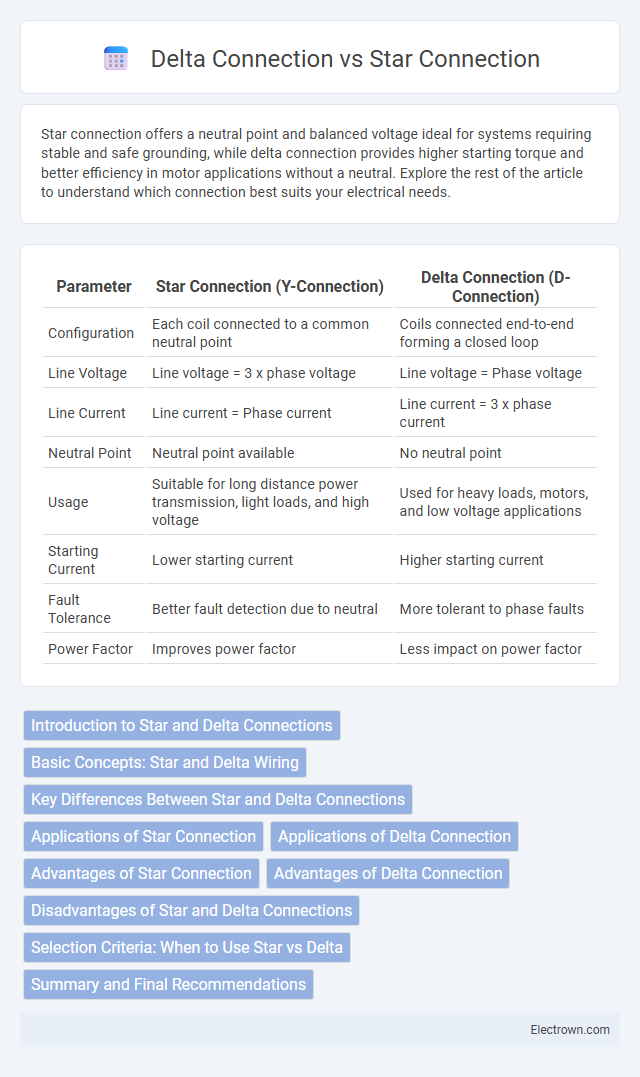Star connection offers a neutral point and balanced voltage ideal for systems requiring stable and safe grounding, while delta connection provides higher starting torque and better efficiency in motor applications without a neutral. Explore the rest of the article to understand which connection best suits your electrical needs.
Table of Comparison
| Parameter | Star Connection (Y-Connection) | Delta Connection (D-Connection) |
|---|---|---|
| Configuration | Each coil connected to a common neutral point | Coils connected end-to-end forming a closed loop |
| Line Voltage | Line voltage = 3 x phase voltage | Line voltage = Phase voltage |
| Line Current | Line current = Phase current | Line current = 3 x phase current |
| Neutral Point | Neutral point available | No neutral point |
| Usage | Suitable for long distance power transmission, light loads, and high voltage | Used for heavy loads, motors, and low voltage applications |
| Starting Current | Lower starting current | Higher starting current |
| Fault Tolerance | Better fault detection due to neutral | More tolerant to phase faults |
| Power Factor | Improves power factor | Less impact on power factor |
Introduction to Star and Delta Connections
Star and Delta connections represent fundamental wiring configurations in three-phase electric power systems, essential for motor and transformer connections. The Star connection, also known as the Y-connection, links one end of each of the three coils to a common neutral point, facilitating both line and phase voltage measurements. In contrast, the Delta connection forms a closed loop with each coil connected end-to-end, providing higher starting torque and distributing load current evenly across phases.
Basic Concepts: Star and Delta Wiring
Star connection wiring features three components connected at a central neutral point, creating a Y-shaped configuration ideal for distributing voltage evenly across loads. Delta connection wiring forms a closed loop where each component is connected end-to-end, enabling higher current flow and better power handling in heavy-duty applications. Understanding these fundamental wiring patterns helps optimize your electrical system's efficiency and stability.
Key Differences Between Star and Delta Connections
Star and Delta connections differ primarily in their wiring configurations, where Star connects each coil to a common neutral point, forming a 'Y' shape, while Delta connects coils end-to-end in a closed loop. Voltage and current characteristics also vary; Star provides phase voltage equal to line voltage divided by 3 and line current equal to phase current, whereas Delta offers line voltage equal to phase voltage and line current equal to phase current multiplied by 3. These differences impact application suitability, with Star preferred for high voltage, low current scenarios and Delta suited for low voltage, high current operations.
Applications of Star Connection
Star connection is widely used in power distribution systems and electrical grids due to its ability to provide a neutral point, enabling the supply of both line-to-line and line-to-neutral loads. This configuration is ideal for long-distance transmission as it reduces insulation requirements and manages voltage levels efficiently by dividing the phase voltage. Your industrial or residential systems benefit from star connection when balanced loads and stable voltage supply are essential for safe and reliable operation.
Applications of Delta Connection
Delta connection is commonly used in industrial applications requiring high starting torque, such as motors driving pumps, compressors, and conveyors. It offers better phase balance and can handle heavy loads, making it ideal for three-phase power distribution systems in manufacturing plants. Your equipment benefits from the improved efficiency and fault tolerance provided by the delta connection.
Advantages of Star Connection
Star connection offers better voltage stability and is ideal for long-distance power transmission due to its neutral point, which allows for the use of both single-phase and three-phase loads. It enhances safety by reducing the risk of electrical shock and facilitates easier fault detection and isolation in electrical networks. This configuration also reduces insulation requirements and is more cost-effective for high-voltage distribution systems.
Advantages of Delta Connection
Delta connection offers higher power output and improved efficiency for three-phase motors, making it ideal for heavy industrial applications. Its design provides better load balancing and enables the motor to operate at full voltage during starting, enhancing performance and reliability. You benefit from reduced electrical losses and the ability to sustain higher torque under varying load conditions.
Disadvantages of Star and Delta Connections
Star connections suffer from lower power output due to the phase voltage being less than the line voltage, which limits their efficiency in high-demand applications. Delta connections create circulating currents within the network, leading to increased power losses and potential overheating in the system. Your choice between these configurations should consider the trade-offs in power efficiency and thermal management inherent to each connection type.
Selection Criteria: When to Use Star vs Delta
Star connection is preferred for systems requiring neutral grounding and reduced phase voltage, making it suitable for long-distance power transmission and situations needing lower starting currents. Delta connection is ideal for applications demanding higher starting torque and more power output without a neutral point, commonly used in industrial motors and heavy loads. The choice between star and delta connections depends on load characteristics, voltage requirements, and the need for system grounding.
Summary and Final Recommendations
Star connection offers a neutral point, enabling stable voltage and suitability for long-distance power transmission with lower line currents, while delta connection provides higher starting torque and better motor efficiency in industrial applications. For your specific needs, choose star connection if voltage stability and safety are priorities, and opt for delta connection when requiring higher power output and torque. Assess load requirements and system design carefully to maximize performance and energy efficiency.
Star Connection vs Delta Connection Infographic

 electrown.com
electrown.com